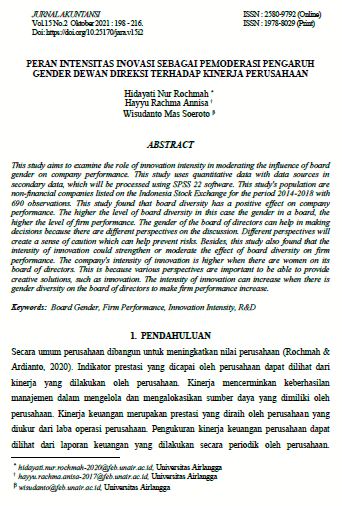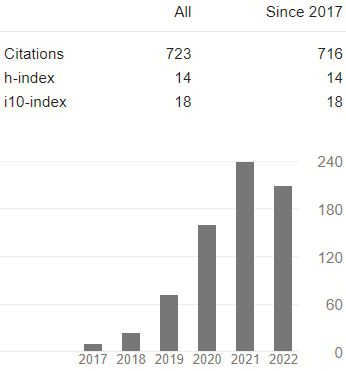Influence Of Gender Of The Board Of Directors On Firm Performance With The Intensity Of Innovation As Moderate Variable
DOI:
https://doi.org/10.25170/jak.v15i2.2381Keywords:
Board Gender, Firm Performance, Innovation Intensity, R&DAbstract
ABSTRACT
This study aims to examine the role of innovation intensity in moderating the influence of board gender on company performance. This study uses quantitative data with data sources in secondary data, which will be processed using SPSS 22 software. This study's population are non-financial companies listed on the Indonesia Stock Exchange for the period 2014-2018 with 690 observations. This study found that board diversity has a positive effect on company performance. The higher the level of board diversity in this case the gender in a board, the higher the level of firm performance. The gender of the board of directors can help in making decisions because there are different perspectives on the discussion. Different perspectives will create a sense of caution which can help prevent risks. Besides, this study also found that the intensity of innovation could strengthen or moderate the effect of board diversity on firm performance. The company's intensity of innovation is higher when there are women on its board of directors. This is because various perspectives are important to be able to provide creative solutions, such as innovation. The intensity of innovation can increase when there is gender diversity on the board of directors to make firm performance increase.
References
Aggarwal, R., Jindal, V., & Seth, R. (2019). Board diversity and firm performance: The role of business group affiliation. International Business Review, 28(6). https://doi.org/10.1016/j.ibusrev.2019.101600
Amin, N. N., & Sunarjanto. (2016). Pengaruh Diversitas Dewan Komisaris dan Dewan Direksi Terhadap Kinerja Perusahaan. FOKUS MANAJERIAL Jurnal Manajemen Dan Kewirausahaan, 11(3), 51–66.
Becker-Blease, J. R. (2011). Governance and innovation. Journal of Corporate Finance, 17(4), 947–958. https://doi.org/10.1016/j.jcorpfin.2011.04.003
Cabeza-García, L., Del Brío, E. B., & Rueda, C. (2019). The moderating effect of innovation on the gender and performance relationship in the outset of the gender revolution. Review of Managerial Science, 0123456789. https://doi.org/10.1007/s11846-019-00367-y
Castanias, R. P., & Helfat, C. E. (2001). The managerial rents model: Theory and empirical analysis. Journal of Management, 27(6), 661–678. https://doi.org/10.1177/014920630102700604
Chen, J., Leung, W. S., & Evans, K. P. (2018). Female board representation, corporate innovation and firm performance. Journal of Empirical Finance, 48(July 2016), 236–254. https://doi.org/10.1016/j.jempfin.2018.07.003
Chiang, H.-T., & Lin, M.-C. (2011). Examining Board Composition and Firm Performance. The International Journal of Business and Finance Research, 5(3), 15–27.
Conner, K. (1991). hostorical comparison of RBV (p. 34).
Dezso, C. L. . R. D. G. (2012). DOES FEMALE REPRESENTATION IN TOP MANAGEMENT IMPROVE FIRM PERFORMANCE? A PANEL DATA INVESTIGATION. Strategic Management Journal, 500(January), 1–18. https://doi.org/10.1002/smj
Ellitan, L. (2006). Strategi Inovasi Dan Kinerja Perusahaan Manufaktur Di Indonesia: Pendekatan Model Simultan Dan Model Sekuensial. Jurnal Manajemen, Vol. 6, No. 1, Nov 2006, 6(1), 1–22.
García-Manjón, J. V., & Romero-Merino, M. E. (2012). Research, development, and firm growth. Empirical evidence from European top R&D spending firms. Research Policy, 41(6), 1084–1092. https://doi.org/10.1016/j.respol.2012.03.017
García-Meca, E., García-Sánchez, I. M., & Martínez-Ferrero, J. (2015). Board diversity and its effects on bank performance: An international analysis. Journal of Banking and Finance, 53, 202–214.
https://doi.org/10.1016/j.jbankfin.2014.12.002
Kanter, R. M. (1977). Men and Women of the Corporation. Basic Book.
Khan, W. A., & Vieito, J. P. (2013). Ceo gender and firm performance. Journal of Economics and Business, 67, 55–66. https://doi.org/10.1016/j.jeconbus.2013.01.003
Kılıç, M., & Kuzey, C. (2016). The effect of board gender diversity on firm performance: evidence from Turkey. Gender in Management, 31(7), 434–455. https://doi.org/10.1108/GM-10-2015-0088
Kyaw, K., Olugbode, M., & Petracci, B. (2015). Does gender diverse board mean less earnings management? Finance Research Letters, 14, 135–141. https://doi.org/10.1016/j.frl.2015.05.006
Liu, Y., Wei, Z., & Xie, F. (2014). Do women directors improve firm performance in China? Journal of Corporate Finance, 28, 169–184. https://doi.org/10.1016/j.jcorpfin.2013.11.016
Lome, O., Heggeseth, A. G., & Moen, Ø. (2016). The effect of R&D on performance: Do R&D-intensive firms handle a financial crisis better? Journal of High Technology Management Research, 27(1), 65–77. https://doi.org/10.1016/j.hitech.2016.04.006
Low, D. C. M., Roberts, H., & Whiting, R. H. (2015). Board gender diversity and firm performance: Empirical evidence from Hong Kong, South Korea, Malaysia and Singapore. Pacific Basin Finance Journal, 35, 381–401. https://doi.org/10.1016/j.pacfin.2015.02.008
M, F. (2006). Analisis Gender dan Transformasi Sosial. Pustaka Pelajar.
McGuire, J., & Taylor, E. (2017). Board of Director and Committee Diversity and Firm Financial Performance. Academy of Management Proceedings, 2017(1), 14207. https://doi.org/10.5465/ambpp.2017.14207abstract
Mutmainah, S. (2007). Studi tentang perbedaan evaluasi etis, intensi etis (Ethical Intention) dan orientasi etis dilihat dari gender dan disiplin ilmu : Potensi Rekruitmen Staf Profesional pada Kantor Akuntan Publik. Jurnal Riset Akuntansi Indonesia, 10(1), 43–67.
Novilia, O., & Nugroho, P. I. (2016). Pengaruh Manajemen Puncak Wanita Terhadap Manajemen Laba. Dinamika Akuntansi, Keuangan Dan Perbankan, 5(1), 27–45.
Oldham, G. R., & Cummings, A. (1996). Employee creativity: Personal and contextual factors at work. Academy of Management Journal, 39(3), 607–634. https://doi.org/10.2307/256657
Østergaard, C. R., Timmermans, B., & Kristinsson, K. (2011). Does a different view create something new? the effect of employee diversity on innovation. Research Policy, 40(3), 500–509. https://doi.org/10.1016/j.respol.2010.11.004
Peni, E., & Vähämaa, S. (2010). Female executives and earnings management. Managerial Finance, 36(7), 629–645. https://doi.org/10.1108/03074351011050343
Perrault, E. (2015). Why Does Board Gender Diversity Matter and How Do We Get There? The Role of Shareholder Activism in Deinstitutionalizing Old Boys’ Networks. Journal of Business Ethics, 128(1), 149–165. https://doi.org/10.1007/s10551-014-2092-0
Perryman, A. A., Fernando, G. D., & Tripathy, A. (2016). Do gender differences persist? An examination of gender diversity on firm performance, risk, and executive compensation. Journal of Business Research, 69(2), 579–586. https://doi.org/10.1016/j.jbusres.2015.05.013
Pfeffer, J., & Salancik, G. (1978). The External Control of Organizations: A Resource Dependence Perspective. Harper & Row.
Reguera-Alvarado, N., de Fuentes, P., & Laffarga, J. (2017). Does Board Gender Diversity Influence Financial Performance? Evidence from Spain. Journal of Business Ethics, 141(2), 337–350. https://doi.org/10.1007/s10551-015-2735-9
Sila, V., Gonzalez, A., & Hagendorff, J. (2016). Women on board: Does boardroom gender diversity affect firm risk? Journal of Corporate Finance, 36(December 2013), 26–53. https://doi.org/10.1016/j.jcorpfin.2015.10.003
Torchia, M., Calabrò, A., & Huse, M. (2011). Women Directors on Corporate Boards: From Tokenism to Critical Mass. Journal of Business Ethics, 102(2), 299–317. https://doi.org/10.1007/s10551-011-0815-z
Wang, Y., & Clift, B. (2009). Is there a “business case” for board diversity? Pacific Accounting Review, 21(2), 88–103. https://doi.org/10.1108/01140580911002044

Downloads
Published
Issue
Section
License
Authors who publish with this journal agree to the following terms:
- Authors retain copyright and grant the journal right of first publication with the work simultaneously licensed under a Creative Commons Attribution-ShareAlike 4.0 International License that allows others to share the work with an acknowledgment of the work's authorship and initial publication in this journal.
- Authors are able to enter into separate, additional contractual arrangements for the non-exclusive distribution of the journal's published version of the work (e.g., post it to an institutional repository or publish it in a book), with an acknowledgment of its initial publication in this journal.
- Authors are permitted and encouraged to post their work online (e.g., in institutional repositories or on their website) prior to and during the submission process, as it can lead to productive exchanges, as well as earlier and greater citation of published work.














